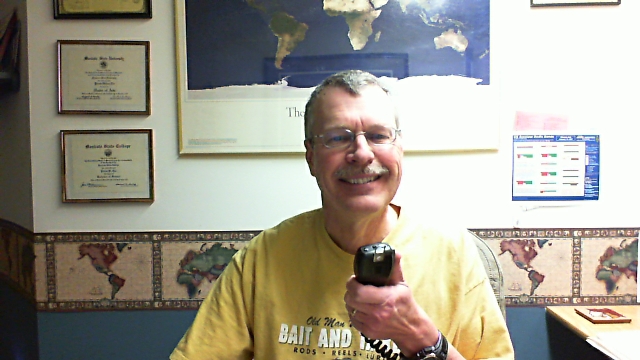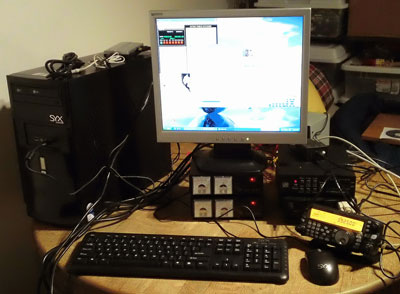Welcome to Handiham World!
Troubleshooting 101 continued: "My antenna is generating electricity and giving me shocks!"

Recap: Last week we presented the following scenario and invited comments:
We are going back in time to when I worked at an antenna company, a job that often involved talking directly to customers on the phone. I would answer questions and make suggestions about installation and troubleshooting. One fine day we got a call from a fellow who had installed one of our vertical antennas. He had ground mounted it, carefully following the instructions in the manual. This antenna came with an aluminum mounting post that was dug into the ground and usually secured with a bag of do-it-yourself concrete mix. A fiberglass dowel in the exposed end of the mounting post served as an insulator and supported the vertical element of the antenna. The center conductor of an included length of a matching section of 75 Ohm coaxial cable was connected with a stainless steel bolt to the main radiating element and the braid was connected to another stainless bolt on the grounded mounting post as well as to a ground rod within inches of the antenna base. The customer had to supply the remaining run of 50 Ohm coax from the ham shack out to the antenna and connect it to the already installed matching section with a barrel connector. When the customer called us, he complained that his antenna was generating electricity and giving him shocks. He noticed this as he was trying to connect the two pieces of coax together.
Can you guess what was wrong and suggest what questions I might have asked the customer to verify my theory? For bonus points, what did I have to tell him to resolve the problem?
I got some good comments back from you, so it's time to share your brilliance in troubleshooting with our readers and listeners:
| From Tom, WA6IVG: Unless he'd driven the antenna's mounting rod into a buried power cable, (unlikely) the problem just about has to be bad station ground. Ask exactly what the coax run is connected to, and how said equipment is grounded. If the station isn't closely connected, with heavy wire or braid, to the electrical service ground, or better yet to a separate ground rod and said service ground, then that's what to do. Also check that power main connections are two standard 3 prong grounded outlet boxes. In a totally desperate situation, of 2 prong power, maybe reversing 2 prong cords could provide a temporary, unorthodox solution but bad idea. If all is claimed to be as it should be, then his station and antenna must be on 2 different continents. | |
| From Mike, KJ6CBW: The customer was getting shocked when connecting the long run of coax to the 75-ohm run from the ground-mounted vertical that has its coax braid connected to ground rods. The two coax cables are at different ground potentials. I think the most likely cause is that the station is not grounded because the power line isn't grounded or a 2-wire plug is being used where a 3-wire plug is appropriate. Another possibility it that the ground rods at the antenna intercepted a buried telephone line or cable-company cable, which make the antenna ground different from that of the long coax. Please don't shoot me, I'm new at this. ..! | |
| And fasten your seatbelt for this one from Kevin, [formerly: N1PKE ]: I have been pondering your *Troubleshooting 101, query, supra, and have attempted to extrapolate a scenario that would lead to such a conclusion as that of getting poked with an electrical current while I was hooking-up my antenna feed-line connections; wherein initially, I would cast basic common-sense to the literal wind, and just to make sure that things were to be a little more interesting, I would wait until the middle of the frigid winter season, for a night when there was very little light and there was then, e.g., currently, a frozen sleet / snow storm with full-gale winds occurring; just to make sure that Mr. Murphy would have all of the available advantages to be had, at his disposal; oh, and I would purposely plug-in and turn-on, e.g., charge my electrical circuitry with an electrical current, just to make sure that if anything went horribly wrong, that it would be the last time that I would ever have to address such a problematic situation. After all, why would I want to abrasively clean-up & 'tin' any of my integral and important electrical connections? I simply would refuse to apply any dielectric dope-grease and/or silicon caulk to any of my in-line electrical components and/or fixtures; and, as a matter of establishing a ground, I would first, have several-hundred yards of my fertile, composted soil removed, and then replaced with several hundred yards of coarse beach sand, just to make sure that I had an earthen environment that promoted instability of antenna constructive support and near zero ohms of conductivity. In this way, I would have assured myself, of having an almost completely isolated radiating antenna element, that I could then have used to have my soaked, limpid corpse hung-up on, as an object lesson for folks whom mistakenly believed that incessant adherence to safety considerations were foolhardy ruminations to be utilized by keenly sensitive brainiacs, wherein, I would think that I would in the future, be included in a list of: "DO NOT TRY THIS AT HOME or ANYWHERE ELSE Listings", those listed, right next and/or near to, my newspaper obituary listing! I think I got it right? |
Wow, those are all great comments. Of course the antenna didn't "generate" electricity. Our wise readers and listeners know that the difference in potential exists when all pieces of equipment in the station and out at the antenna are not at the same ground potential. One of the first questions I asked the customer (knowing about the possibility of that ground potential problem) was whether he had unplugged the station equipment in the ham shack from the AC power mains. He had not, and because the station was not properly grounded, there was a potentially dangerous voltage difference between the plugged-in radio and the grounded antenna. I felt that he was lucky not to have been electrocuted! Kevin's "Do not try this at home" applies here for sure. Always disconnect equipment from the AC mains before doing any service on your antennas and feedlines. This is especially important to remember as we get warmer weather and our thoughts turn toward doing some of that antenna work we have been putting off during the cold winter months. And I mustn't forget: Although I do ground my station equipment, I never trust the ground to protect me. I always disconnect the power before working on the antenna system, because I know that a grounding system might fail. There is no sense taking unnecessary risks when you are working around any kind of electrical equipment.
Another thought that was brought up is the possibility of a ground rod hitting a buried power cable. The way to avoid that problem is to be sure that your antenna site is clear of underground utilities. Find out from your utility company what number to call to set up a free inspection and marking of your property so that you will know where underground lines are buried. Here in my area we have a single number to call and they send out a worker to mark underground lines like gas and electric with spray paint right on the ground over the lines. "Gopher State One Call" is our system, but you will have a similar service in your area. Be aware, though, that such services will not let you know about things like the location of underground lawn sprinkling systems that are not part of the utility system.
Since the antenna in question was a vertical, one has to be especially careful assembling it on the ground and then swinging it up into place on the mounting post. You have yourself a 26 foot long aluminum stick and you are holding it with both hands, so you most definitely do not want to swing it up into a power line! Since my caller was in fact alive to call and tell me that his antenna was "generating electricity", I pretty much assumed that he didn't make that particular mistake. Direct contact with even a household power line in such a situation is often deadly because the current will flow from power line to antenna through the victim's arms and through the chest cavity, where it will likely cause the heart to stop or go into arrhythmia.
Anyway, when you are answering customer complaints like this one, the most likely cause usually turns out to be the right one. He had indeed left the rig plugged into the AC mains and was getting a shock because of some fault in his equipment or station ground.
Stay safe and out of the obituaries!





